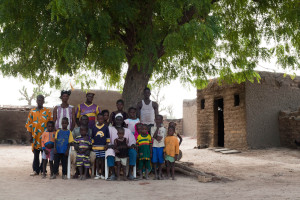May 5, 2014
This summer, I will be conducting research throughout Mali to examine the relationship between rural households’ food security situation and their participation in markets.
In Mali, a farming household will usually market its agricultural products either by simply selling on open markets or to traders. However, in other cases (which are somewhat rare for the case of Mali), farmers and farmer organizations will enter into longer term contractual relationships with agribusiness such as cereal mills in order to better link themselves to modern markets. My primary research question seeks to explore how these different modes of market participation work, and what their impacts are on household food security and other outcomes at the household and community level. As food security is a complicated and multi-orbed concept, my blog posts will likely touch on related topics that contribute to and describe food security in Mali, including climate variability, supply chain and market systems, household food access, and nutrition.
 To study these issues, my field research will focus on three or four rural communities in which farmers are participating in supply chains through some form of contract farming. About half of my time at each site will be spent with a random selection of such contract farmers, and the other half will be spent with households which do not participate in contract farming. I will also be collecting data from key community members and organizations and other supply chain actors in order to get a broader, system-wide understanding of the market’s role in food security.
To study these issues, my field research will focus on three or four rural communities in which farmers are participating in supply chains through some form of contract farming. About half of my time at each site will be spent with a random selection of such contract farmers, and the other half will be spent with households which do not participate in contract farming. I will also be collecting data from key community members and organizations and other supply chain actors in order to get a broader, system-wide understanding of the market’s role in food security.
My primary data collection tools will be photography and semi-structured interviews, and I hope to devote at least a couple blog posts to my ongoing reflections on how photography can potentially be used as a tool in the data collection, analysis, and reporting stages of agricultural economic research. As my field research evolves, I also plan to post photographs from the field in addition to preliminary observations and findings.
In addition to thanking the Howard G. Buffet Foundation and Texas A&M for their support and the opportunity to conduct this summer’s research, I would also like to gratefully acknowledge the additional support provided by the Syngenta Foundation; the Agricultural, Food, and Resource Economics Department at Michigan State University, and the African Studies Center at Michigan State University.
June 2, 2014
Mali Farming Household Profile #1: Millet and Sorghum in Segou
I have been in Mali for about three weeks now, and just completed the field work for my first case study, which focuses on the agricultural livelihoods and commercial activities of millet and sorghum farmers in the central region of Segou. The small sample of farming families that I spent time with are members of a large producers’ union—Mali’s largest, actually—that provides an important packages of services to its farmer members. First, each year prior to the agricultural campaign, the union helps farmers to plan their coming year’s food needs and to project agricultural surplus. Based on this planning exercise, the union then signs a one-year contract with the farmer which provides him or her with credit for agricultural inputs. At harvest the union pays an agreed-upon purchase price to the farmer for its surplus millet and sorghum, minus input costs. Technical assistance and marketing services are also provided to farmers, and at the end of the commercial season any profits are returned to farmer members as a dividend payment. Millet and sorghum are important food security crops in Mali both because of the great latitude with which they are consumed, but also because they are among the basic crops that farmers market to meet household needs for which only cash can provide.

Below are select photos gathered from my multiple household visits, which provide a rough profile of the kind of farming households which participate in this kind of contracting partnership. According to the FEWS NET Livelihood Profiles for this zone of Mali (the west and central rain-fed millet/sorghum zone), these households’ demographic, agricultural, and economic characteristics roughly suggest that they belong in the middle wealth group categories — in either “poor” or “middle” — but neither “wealthy” nor “very poor.”
Production
While I was not able to catch planting activities (which get started in the next few weeks), during the interviews farmers exhibited some of their tools and equipment.